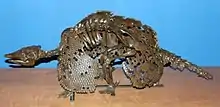Pachyarmatherium
Pachyarmatherium is a genus of extinct large armadillo-like cingulates found in North and South America from the Pliocene and Pleistocene epochs, related to the extant armadillos and the extinct pampatheres and glyptodonts.[2] It was present from 4.9 Mya to 11,000 years ago, existing for approximately 4.889 million years .
| Pachyarmatherium | |
|---|---|
 | |
| Mounted skeleton | |
| Scientific classification | |
| Kingdom: | Animalia |
| Phylum: | Chordata |
| Class: | Mammalia |
| Order: | Cingulata |
| Family: | †Pachyarmatheriidae Fernicola, Rinderknecht, Jones, Vizcaino, & Porpino, 2018[1] |
| Genus: | †Pachyarmatherium Downing & White, 1995 |
| Species | |
|
† P. leiseyi Downing & White, 1995 | |
Taxonomy

Pachyarmatherium was named by Downing and White (1995). Its type is P. leiseyi. It was assigned to Dasypodoidea by Downing and White (1995), and tentatively to Glyptodontidae by McKenna and Bell (1997).[3][4] A cladistic analysis performed by de O. Porpino et al. (2009) led to the conclusion that Pachyarmatherium is a sister group to a clade consisting of Glyptodontidae and Pampatheriidae.[2] Oliveira et al. (2013) suggest that Pachyarmatherium is a possible dasypodid.[5]
Fossil distribution of Pachyarmatherium
P. leiseyi
- Kissimmee River site, Tamiami Formation, Okeechobee County, Florida ~4.9—1.8 Mya.
- Haile 16A Site, Alachua County, Florida ~1.8 Mya.—300,000 years ago.
- Payne Creek Mine, Polk County, Florida ~1.8 Mya—300,000 years ago.
- Leisey Shell Pit 1A, Bermont Formation, Hillsborough County, Florida ~1.8—300,000 years ago.
P. tenebris
References
- Fernicola, J. C.; Rinderknecht, A.; Jones, W.; Vizcaíno, S. F.; Porpino, K. (2018). "A New Species of Neoglyptatelus (Mammalia, Xenarthra, Cingulata) from the Late Miocene of Uruguay Provides New Insights on the Evolution of the Dorsal Armor in Cingulates". Ameghiniana. 55 (3): 233–252. doi:10.5710/AMGH.02.12.2017.3150. hdl:11336/96801.
- de O. Porpino, K.; Fernicola, J. C.; Bergqvist, L. P. (September 2009). "A New Cingulate (Mammalia: Xenarthra), Pachyarmatherium brasiliense sp. nov., from the Late Pleistocene of Northeastern Brazil". Journal of Vertebrate Paleontology. Society of Vertebrate Paleontology. 29 (3): 881–893. doi:10.1671/039.029.0305. Retrieved 2009-11-30.
- K. F. Downing and R. S. White. 1995. The cingulates (Xenarthra) of the Leisey Shell Pit local fauna (Irvingtonian), Hillsborough County, Florida. Bulletin of the Florida Museum of Natural History 37(12):375-396
- M. C. McKenna and S. K. Bell. 1997. Classification of Mammals Above the Species Level 1-640
- Oliveira, É. V.; de O. Porpino, K.; da Silva, F. M. (2013). "New material of Pachyarmatherium from the late Pleistocene of northeastern Brazil: insights into its morphology and systematics". Paläontologische Zeitschrift. 87 (4): 505–513. doi:10.1007/s12542-013-0166-4.
- "Fossilworks: Pachyarmatherium tenebris". fossilworks.org. Retrieved 2016-01-23.
- "Fossilworks: Gateway to the Paleobiology Database". fossilworks.org. Retrieved 2016-01-23.
- "Fossilworks: Pachyarmatherium brasiliense". fossilworks.org. Retrieved 2016-01-23.
- "Fossilworks: Lajedo de Escada (Pleistocene of Brazil)". fossilworks.org. Retrieved 2016-01-23.
Further reading
- Guimarães de Lima, Fábio Cunha, and Kleberson de Oliveira Porpino. 2018. Ectoparasitism and infections in the exoskeletons of large fossil cingulates. PLoS ONE 13. e0205656. Accessed 2018-10-18.